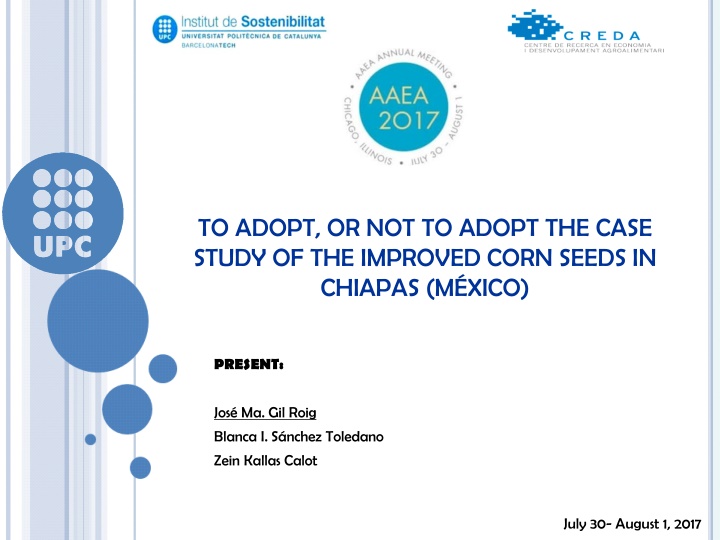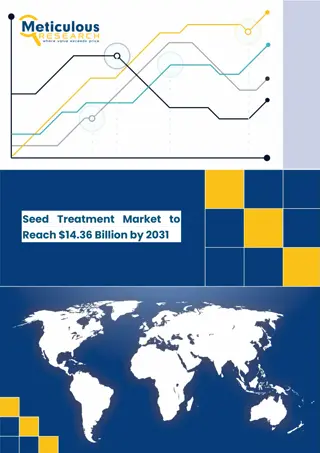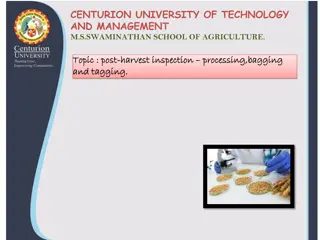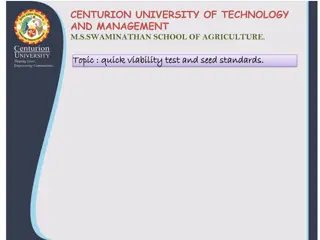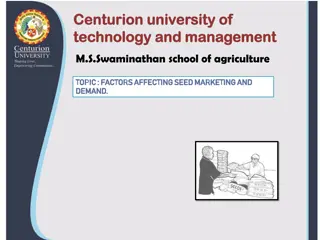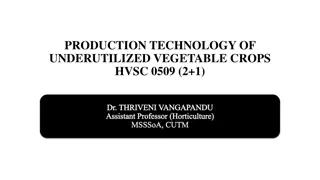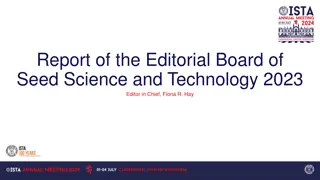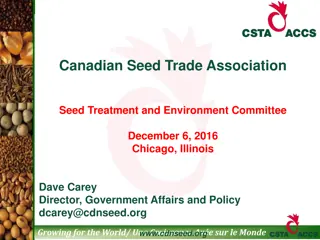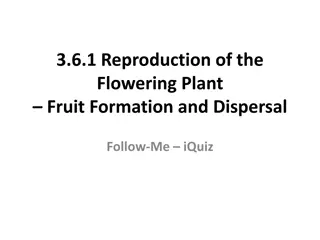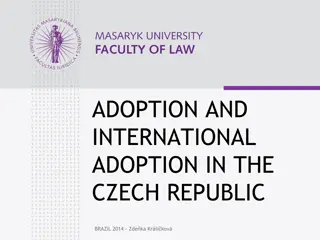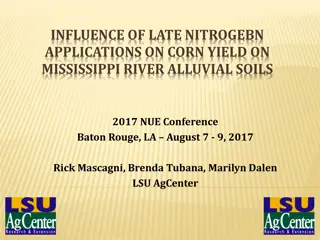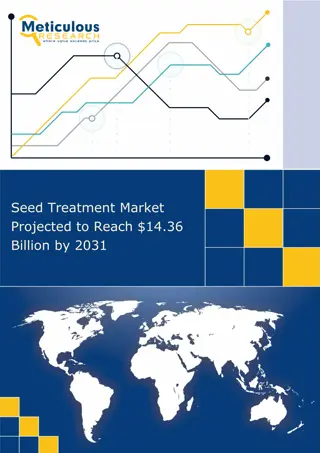Improved Corn Seed Adoption in Chiapas, Mexico
Analyzing the adoption rate of improved maize seeds in Chiapas, Mexico, focusing on factors influencing farmers' decisions. The study explores farmers' characteristics, economic data, and external factors affecting seed adoption. Insights are drawn from a survey conducted among a sample of 200 farmers. The research aims to enhance corn production to meet increasing demand and improve food security in Mexico.
Download Presentation

Please find below an Image/Link to download the presentation.
The content on the website is provided AS IS for your information and personal use only. It may not be sold, licensed, or shared on other websites without obtaining consent from the author.If you encounter any issues during the download, it is possible that the publisher has removed the file from their server.
You are allowed to download the files provided on this website for personal or commercial use, subject to the condition that they are used lawfully. All files are the property of their respective owners.
The content on the website is provided AS IS for your information and personal use only. It may not be sold, licensed, or shared on other websites without obtaining consent from the author.
E N D
Presentation Transcript
TO ADOPT, OR NOT TO ADOPT THE CASE STUDY OF THE IMPROVED CORN SEEDS IN CHIAPAS (M XICO) PRESENT: Jos Ma. Gil Roig Blanca I. S nchez Toledano Zein Kallas Calot July 30- August 1, 2017
1. Introduction 2. Methodology 3. Results and discussion To improve and ensure Mexican food security policy, corn production should reach higher level that meet the increasing demand for corn. 4. Conclusions Mexico has resorted to importing corn with 10.7 million tons in 2015 (SIAP, 2016). 5. References The maize seed improvement in Mexico in the last fifty years is one of the most studied topics in agricultural research, partnered with the objective to increase its adoption.
1. Introduction 2. Methodology 3. Results and discussion Acceptance of the improved seeds remains low amongst farmers, particularly small farmers. 4. Conclusions 5. References The planted area only represents 2.7 million hectares of a total of 6.1 million hectares of total production in Mexico (Rodr guez et al. 2015). The state of Chiapas has the largest demand for corn seed and the highest potential for increasing production; however, it is still one of the states with the lowest adoption rates of improved seeds (30%), due to the low-perceived advantage of this technology (SIAP 2016). 3
1. Introduction 2. Methodology 3. Results and discussion 4. Conclusions 5. References The aim of this research is to analyze the adoption rate of improved maize seeds over time through a survival analysis in one of the states with the largest corn production in Mexico. We seek to assess the influence of farmer characteristics, farm structure, farm economic data, external factors, farm management, and farm results by producer. 4
1. Introduction 2. Methodology 3. Results and discussion Data was collected from a face to face survey at farm level with a sample of 200 farmers carried out during January to March 2015. 4. Conclusions The sample was stratified by Regions: Villaflores, Chiapas de Corzo, Villacorzo, and La Concordia. Seed type: creole and improved 5. References - The dependent variable was the time that farmers last to adopt or not the improved seed by the date of the survey. - The start date was set as the year in which the farmer was responsible for managing the activities and cultivating corn. - The end period was set as the year in which the farmer adopted the improved seeds. 5
1. Introduction 2. Methodology The variables used were: 3. Results and discussion Household head age Education Information Members The year of the last agricultural policy reform the Free Trade Agreement with North America (NAFTA) in 1994 Working family members Generations in agriculture Generations in planting corn Number of courses received Total farm size Yield Attitudes Opinions and perceptions 4. Conclusions 5. References 6
1. Introduction 2. Methodology Confirmatory Principal Component Analysis (CPCA) 3. Results and discussion The affirmations regarding the farmers opinions toward the improved seeds were: a) The revenue obtained from the improved maize are able to cover the higher production costs b) Planting using the improved seeds can ensure the future of farms c) Seeding with improved maize seeds positive exploitation d) Planting the improved seeds sill increase the household income e) The improved seeds have better market acceptance f) The masa-tortilla relationship is greater with the improved seeds. The affirmation regarding the risks may farmer perceive from using the improved seeds were: a) lower b) proliferation c) d) fluctuation e) f) 4. Conclusions 5. References The risks from market is The risks from pest The risk to credit access The The risk from drought The risk of production loss risk from yield contributes image to a for the 7
1. Introduction 2. Methodology 3. Results and discussion The first confirmatory factor regarding farmers opinions that explained the 68% of the variability of the original variables was named positive opinion towards the improved seeds . 4. Conclusions 5. References The second confirmatory factor regarding the risk perception that capture 56% of the total variability was named risk lover behaviour . 8
1. Introduction 2. Methodology 3. Results and discussion 4. Conclusions 5. References Figure 1. Kaplan-Meier survival estimate 9
1. Introduction 2. Methodology 3. Results and discussion Table 1. Results of the Cox proportional model for the adoption of improved seeds 4. Conclusions e( ) Variables P value 5. References Household head age -1.22 0.29 0.000*** Number of generations in agriculture 0.22 1.25 0.050** NAFTA reform (year 1994) -1.86 0.15 0.000*** Number of family workers -0.37 0.68 0.000*** Number of received courses and extension contact for best farming practices PCA: Perception factor for accepting improved seeds 1.65 5.25 0.000*** 0.44 1.55 0.001** PCA: Risk behavior (risk lover) 0.45 1.57 0.010* Pseudo R2 0.76 10
1. Introduction 2. Methodology 3. Results and discussion Our results showed that 60% of farmers adopted the improved seeds within the first 10 years after they were responsible for the farm. 4. Conclusions 5. References Likewise, our study confirmed that young farmers with low numbers of family members and high numbers of generations, who are dedicated to agriculture, has sufficient information about innovation, and are willing to take risks, are more likely to adopt improved seeds. Results also revealed the incapacity of the agricultural reform of NAFTA in 1994 to ensure sustainable economic growth. The importance of government support during the production process and to control the volatility of market prices may play an important role in mitigating risk perception. 11
1. Introduction 2. Methodology 3. Results and discussion Additionally, extension efforts should be strengthened to increase the flow of information to farmers. 4. Conclusions 5. References Similarly, courses from qualified agents may increase the likelihood to change toward the adoption of improved maize seed. Policies promoting the adoption of improved seed maize should take into account the nature and factors that determine the adoption rate. The understanding of the dynamics the adoption may help improve strategies to accelerate adoption. 12
1. Introduction 2. Methodology Albert, S., & Duffy, J. (2012). Differences in risk aversion between young and alder adults. Neuroscience and Neuroeconomics, 2(1), 3 9. doi:10.2147/NAN.S27184 Asrat, S., Yesuf, M., Carlsson, F., & Wale, E. (2010). Farmers preferences for crop variety traits: Lessons for on-farm conservation and technology adoption. Ecological Economics, 69(12), 2394 2401. Becerril, J., & Abdulai, A. (2010). The Impact of improved maize varieties on poverty in Mexico: A propensity score-matching approach. World Development, 38(7), 1024 1035. doi:10.1016/j.worlddev.2009.11.017 Beyene, D., & Kassie, M. (2015). Speed of adoption of improved maize varieties in Tanzania: An application of duration analysis. Technological Forecasting and Social Change, 96, 298 307. doi:10.1016/j.techfore.2015.04.007 Birol, E., Smale, M., & Yorobe, J. (2012). Bi-modal preferences for bt maize in the Philippines: A latent class model. AgBioForum, 15(2), 175 190. Brick, K., & Visser, M. (2015). Risk preferences, technology adoption and insurance uptake: A framed experiment. Journal of Economic Behavior & Organization, 118, 383 396. doi:10.1016/j.jebo.2015.02.010 Camberos, M. (2000). La seguridad alimentaria de M xico en el a o 2030. CIENCIA Ergo-Sum, 7(1), 49 55. Cox, D. (1972). Regression models and life tables. Journal of the Royal Statistical Society, 34(2), 187 220. De Cock, L. (2005). Determinants of organic farming conversion. In Paper presented at the XI International Congress of The European Association of Agricultural Economists, Copenhagen, Denmark (No. 24675). (p. European Association of Agricultural Economists). Di Falco, S., & Bulte, E. (2011). A dark side of social capital? kinship, consumption, and savings. Journal of Development Studies, 47(8), 1128 1151. doi:10.1080/00220388.2010.514328 Dibba, L., Zeller, M., Diagne, A., & Nielsen, T. (2015). How accessibility to seeds affects the potential adoption of an improved rice variety: The case of the new rice for Africa (NERICA) in the Gambia. Quarterly Journal of International Agriculture Quarterly Journal of International Agriculture Quarterly Journal of International Agriculture, 54(1), 33 58. Dohmen, T., Falk, A., Huffman, D., & Sunde, U. (2010). Are risk aversion and impatience related to cognitive ability? American Economic Review, 100, 1238 1260. doi:10.1257/aer.100.3.1238 Feder, G., Just, R., & Zilberman, D. (1985). Adoption of agricultural innovations in developing countries: A survey. Economic Development and Cultural Change, 33(2), 55 298. Ghadim, A., Pannell, D., & Burton, M. (2005). Risk, uncertainty, and learning in adoption of a crop innovation. Agricultural Economics, 33(1), 1 9. doi:10.1111/j.1574-0862.2005.00433.x Hattam, C. E., Lacombe, D. J., & Holloway, G. J. (2012). Organic certification, export market access and the impacts of policy: Bayesian estimation of avocado smallholder times-to-organic certification in Michoac n Mexico. Agricultural Economics, 43(4), 441 457. doi:10.1111/j.1574- 0862.2012.00595.x Hellin, J., & Bellon, M. (2007). Manejo de semillas y diversidad del ma z AgriCultures Network. LEISA Revista de Agroecolog a, 23(2), 9 11. Kafle, B. (2010). Determinants of adoption of improved maize varieties in developing countries: a review. International Research Journal of Applied and Basic Sciences, 1(1), 1 7. Klein, J. P., & Moeschberger, M. L. (2003). Survival analysis: statistical methods for censored and truncated data. Springer, New York. Kallas, Z., Serra, T., & Gil, J. (2009). Farmer s objectives as determinant factors of organic farming adoption. In Paper prepared for presentation at the 113th EAAE Seminar A resilient. 3. Results and discussion 4. Conclusions 5. References 13
